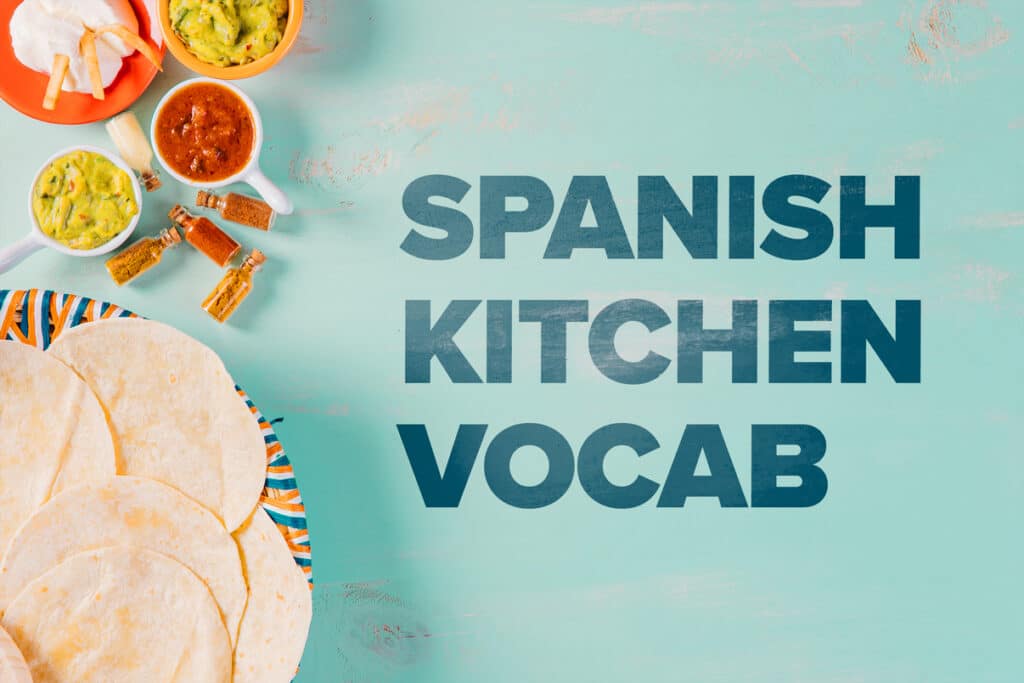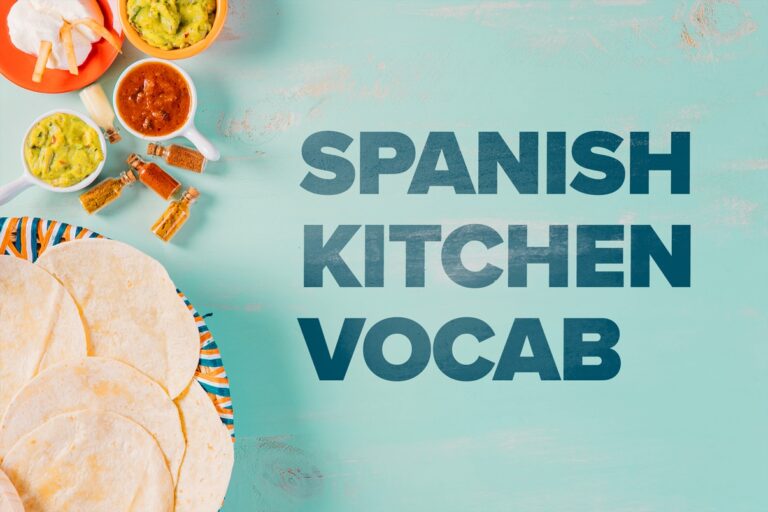
Spanish cuisine is celebrated for its vibrant colors, bold flavors, and passionate preparation methods.
Whether it’s the mouthwatering aroma of a sizzling paella, the tantalizing taste of jamón ibérico, or the refreshing burst of a gazpacho on a hot summer day, Spanish dishes are as diverse as the regions they hail from.
If you’re learning Spanish, it’s worth learning the vocabulary for talking about its delectable food!
Check out over 650 essential Spanish kitchen vocabulary, from common ingredients to cooking techniques and beyond. Plus, see how to talk about items, tools and appliances around the kitchen.
Contents
Download:
This blog post is available as a convenient and portable PDF that you
can take anywhere.
Click here to get a copy. (Download)
Cooking Terms in Spanish
Cooking methods
Culinary techniques
Ingredientes
(Ingredients) and Comida (Food)
Frutas
(Fruits), Verduras
(Vegetables) and Legumbres
(Legumes)
Productos de origen animal
(Animal Products)
Cereales
(Grains), Semillas
(Seeds) and Pastas
(Pastas)
Especias
(Spices)
Salsas
(Sauces) and Condimentos
(Condiments)
Common Spanish Phrases in the Kitchen
| Spanish Words | English Translations |
|---|---|
| ¡Que aproveche! | Enjoy your meal! |
| ¿Cómo te gustaría tu carne cocinada? | How would you like your steak cooked? |
| ¿Me pasas la sal, por favor? | Can you pass me the salt, please? |
| ¿Podrías revolver la salsa por mí? | Could you stir the sauce for me? |
| ¿Puedes ayudarme a cortar las verduras? | Can you help me chop the vegetables? |
| ¿Puedes ayudarme a poner la mesa? | Can you help me set the table? |
| ¿Te gustaría algo de beber? | Would you like something to drink? |
| ¿Te gustaría algo de postre? | Would you like some dessert? |
| ¿Todo está sabroso? | Is everything tasting good? |
| ¿Ya está hirviendo el agua? | Is the water boiling yet? |
| El agua está hirviendo, hora de agregar la pasta. | The water is boiling, time to add the pasta. |
| El pastel está listo; podemos sacarlo del horno. | The cake is ready; we can take it out of the oven. |
| Es hora de voltear los panqueques. | It’s time to flip the pancakes. |
| La receta indica dos tazas de harina. | The recipe calls for two cups of flour. |
| La salsa debe cocinarse a fuego lento durante al menos 15 minutos. | The sauce needs to simmer for at least 15 minutes. |
| La salsa debe cocinarse a fuego lento durante al menos 20 minutos. | The sauce needs to simmer for at least 20 minutes. |
| Necesitamos descongelar el pollo para la cena. | We need to defrost the chicken for dinner. |
| Necesito un cuchillo afilado para cortar esto. | I need a sharp knife to cut this. |
| No olvides poner el temporizador para las galletas. | Don’t forget to set the timer for the cookies. |
| No olvides sazonar las verduras. | Don’t forget to season the vegetables. |
| Nos quedamos sin azúcar, lo agregaré a la lista de compras. | We’re out of sugar, I’ll add it to the shopping list. |
| Pongamos la mesa antes de que lleguen los invitados. | Let’s set the table before the guests arrive. |
| Por favor, lava los platos cuando terminemos de comer. | Please wash the dishes after we’re done eating. |
| Por favor, pásame la tabla de cortar. | Please pass me the cutting board. |
| Ten cuidado con la sartén caliente, usa manoplas. | Be careful with the hot pan, use oven mitts. |
| Ten cuidado, la estufa está caliente. | Be careful, the stove is hot. |
| Voy a batir los huevos para la tortilla. | I’ll whisk the eggs for the omelet. |
| Voy a precalentar el horno. | I’m going to preheat the oven. |
| Yo picaré las cebollas mientras tú pelas las papas. | I’ll chop the onions while you peel the potatoes. |
Cultural Spanish Cuisine Names
- Paella
: A famous Valencian dish made with rice, saffron, vegetables, and a variety of meats like chicken, rabbit, and seafood. - Tapas
: Small, flavorful dishes often served as appetizers or snacks. Common tapas include patatas bravas (fried potatoes with spicy sauce), tortilla española (Spanish omelette), and gambas al ajillo (garlic shrimp). - Gazpacho
: A cold tomato-based soup made with vegetables like cucumbers, bell peppers, and onions, seasoned with olive oil, vinegar, and garlic. - Jamón Ibérico
: A type of cured ham made from black Iberian pigs. It comes in different grades, with acorn-fed jamón (Jamón Ibérico de Bellota) being the most prized. - Churros
: Fried dough pastries, often served with a cup of thick hot chocolate for dipping. - Tortilla Española
: A traditional Spanish omelette made with eggs, potatoes, and sometimes onions. - Bacalao
: Dried and salted codfish, a common ingredient in Spanish cuisine. - Pisto
: A vegetable stew made with tomatoes, peppers, zucchini, onions, and eggplant, often served with a fried egg on top. - Fabada Asturiana
: A hearty bean stew originating from Asturias, made with large white beans, chorizo, morcilla (blood sausage), and pork. - Flan
: A popular Spanish dessert, a creamy custard topped with caramel sauce. - Pulpo a la Gallega
: Galician-style octopus, boiled and served with olive oil, paprika, and coarse sea salt. - Patatas Bravas
: Fried potato cubes served with a spicy tomato-based sauce. - Gambas al Ajillo
: Garlic shrimp cooked in olive oil and chili peppers. - Horchata
: A refreshing drink made from tiger nuts (chufas), sugar, and water. - Escabeche
: A traditional preservation method for fish or meat, marinated in vinegar, oil, and spices. - Crema Catalana
: A custard dessert similar to crème brûlée, topped with a caramelized sugar crust. - Tacos
: Traditional Mexican street food, consisting of tortillas filled with various meats, vegetables, and salsa. - Ceviche
: A popular dish in many Latin American countries, made with raw fish or seafood marinated in citrus juices, spices, and vegetables. - Empanadas
: Savory pastries filled with meat, cheese, or vegetables, widely enjoyed throughout Latin America. - Arepas
: A staple in Colombian and Venezuelan cuisine, these cornmeal cakes are often split open and filled with meats, cheese, or beans. - Pupusas
: Traditional Salvadoran dish, thick corn tortillas filled with cheese, meat, or beans. - Ropa Vieja
: A Cuban shredded beef stew cooked with tomatoes, peppers, and onions. - Cuy
: A traditional dish in the Andean region, particularly in Peru and Ecuador, where guinea pig is roasted or fried. - Arroz con Pollo
: A popular Latin American chicken and rice dish, cooked with various spices and often vegetables. - Pisco Sour
: A famous Peruvian cocktail made with pisco, lemon juice, simple syrup, and egg white. - Pozole
: A traditional spicy Mexican soup or stew made with hominy (large corn kernels) and meat, usually pork or chicken.
Now you’re ready to head to the kitchen and cook up a storm… in Spanish!



